
The rhinoceros hornbill is a large species of forest hornbill (Bucerotidae). In captivity it can live for up to 35 years. It is found in lowland and montane, tropical and subtropical climates and in mountain rain forests up to 1,400 metres in Borneo, Sumatra, Java, the Malay Peninsula, Singapore, and southern Thailand.

The scaled pigeon is a large New World tropical dove. It is a resident breeder from southern Mexico south to western Ecuador, southern Brazil, northern Argentina, and Trinidad.

The zebra dove, also known as the barred ground dove, or barred dove, is a species of bird of the dove family, Columbidae, native to Southeast Asia. They are small birds with a long tail, predominantly brownish-grey in colour with black-and-white barring. The species is known for its pleasant, soft, staccato cooing calls.
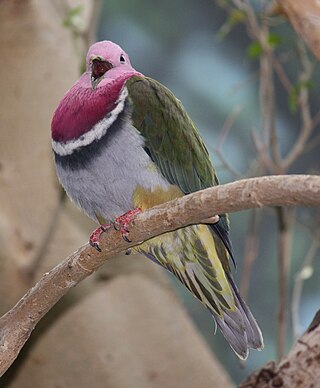
The pink-headed fruit dove also known as pink-necked fruit dove or Temminck's fruit pigeon, is a small colourful dove.
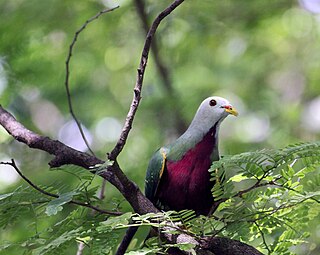
The wompoo fruit dove, also known as wompoo pigeon and "magnificent fruit dove" among others, is one of the larger fruit doves native to New Guinea and eastern Australia.

The whistling fruit dove or whistling dove, also known as the velvet dove or yellow-headed dove, is a small fruit dove from Fiji. The species is endemic to the islands of Kadavu and Ono in the Kadavu Group in the south of Fiji.
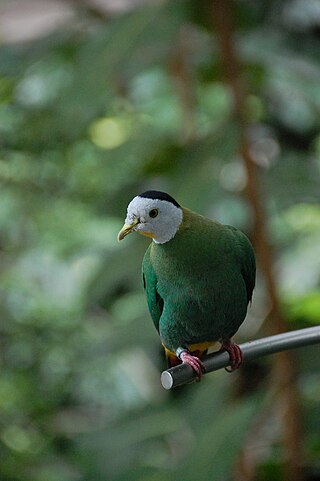
The black-naped fruit dove, also known as the black-headed fruit dove, is a medium-sized, up to 24 cm (9.4 in) long, green fruit dove with yellowish bill and iris. The male has a pale grey head with a black nape, yellow throat, and golden yellow and pink undertail coverts. The plumage of the female and the young is entirely green.

The pale-capped pigeon, also known as the purple wood pigeon, is a species of large pigeon that is found patchily distributed in parts of the Indian subcontinent and Southeast Asia. It has a slow flight and spends a lot of time sitting still in the foliage of large fruiting trees, often in riverine forest on the plains. It is mainly brown above and chestnut below with the a sheen of green or amethyst. Males have a whitish grey cap while females have a brownish grey cap and less gloss on the feathers. They are frugivores, foraging in small groups in the canopy of trees but sometimes descending to the ground for seeds and fallen fruit.
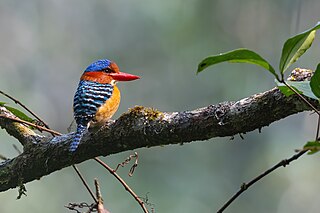
The banded kingfisher is a tree kingfisher found in lowland tropical forests of southeast Asia. It is the only member of the genus Lacedo. Male and female adults are very different in plumage. The male has a bright blue crown with black and blue banding on the back. The female has rufous and black banding on the head and upperparts.

The dark-sided flycatcher is a small passerine bird belonging to the genus Muscicapa in the Old World flycatcher family Muscicapidae. It has a wide breeding distribution in the East Palearctic with northern birds migrating south for the winter. It is also known as the Siberian flycatcher or sooty flycatcher, the latter name is also used for the sooty flycatcher of Africa.

The Pacific imperial pigeon, Pacific pigeon, Pacific fruit pigeon or lupe is a widespread pigeon species in the family Columbidae. It is found in American Samoa, the Cook Islands, the smaller islands of eastern Fiji, Kiribati, Niue, the smaller satellite islands of Papua New Guinea, Samoa, Solomon Islands, Tokelau, Tonga, Tuvalu, Vanuatu, and Wallis and Futuna Islands.

The white-capped fruit dove, also called kuku locally, is a species of bird in the family Columbidae. It was described by French naturalist and surgeon Adolphe-Simon Neboux in 1840. It is endemic to the Marquesas Islands in French Polynesia. The name honours French admiral and botanist Abel Aubert du Petit-Thouars. Two subspecies exist on the islands, Ptilinopus d. dupetithouarsii and Ptilinopus d. viridior.

The dwarf fruit dove is a species of bird in the family Columbidae. It is found in lowland and foothill forest in New Guinea and the Raja Ampat Islands.The dwarf fruit dove weighs 49 grams, about equivalent to the weight of two AA batteries. This bird is the smallest in length of the fruit dove genus.

The many-colored fruit dove, also known as manuma in the Samoan language, is a species of bird in the family Columbidae. It occurs on islands in the south-west Pacific Ocean where it is found in Fiji, the Samoan Islands, and Tonga. Its natural habitat is subtropical or tropical moist lowland forests. Today, the birds are most often found in Fiji and Tonga. It usually feeds high in the canopy on fruit and berries, especially banyan fig. The nest is a small platform of twigs where one white egg is laid.
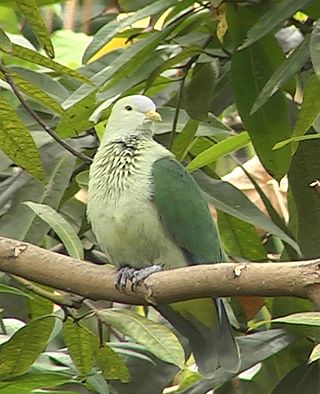
The grey-green fruit dove is a species of bird in the family Columbidae. It is endemic to the Society Islands in French Polynesia. Its natural habitat is subtropical or tropical moist lowland forests.

The claret-breasted fruit dove is a species of bird in the family Columbidae. It is found in the Moluccas, New Guinea and the Solomon Islands archipelago. Its natural habitat is subtropical or tropical moist lowland forests.

The thick-billed green pigeon is a species of bird in the family Columbidae.

The Sunda pygmy woodpecker, also known as the Sunda woodpecker, is a species of bird in the family Picidae. It is found in Brunei, Indonesia, Malaysia, and Singapore. Some taxonomic authorities continue to place this species in the genus Dendrocopos or Picoides.

The grey-and-buff woodpecker is a species of bird in the family Picidae. It is found in Brunei, Indonesia, Malaysia, southern Myanmar, and southern Thailand, but has become regionally extinct in Singapore. Its natural habitats are lowland and montane tropical or subtropical moist broadleaf forests.

The fruit doves, also known as fruit pigeons, are a genus (Ptilinopus) of birds in the pigeon and dove family (Columbidae). These colourful, frugivorous doves are found in forests and woodlands in Southeast Asia and Oceania. It is a large genus with over 50 species, some threatened or already extinct.





















